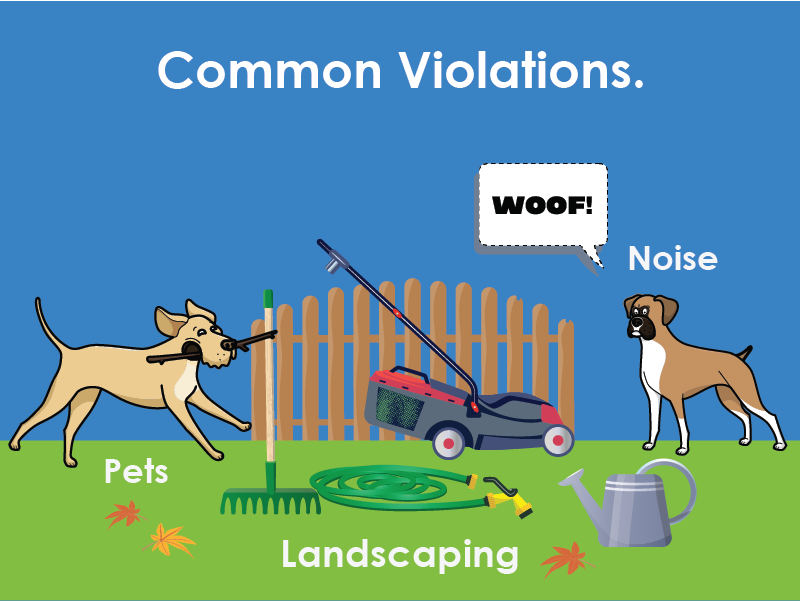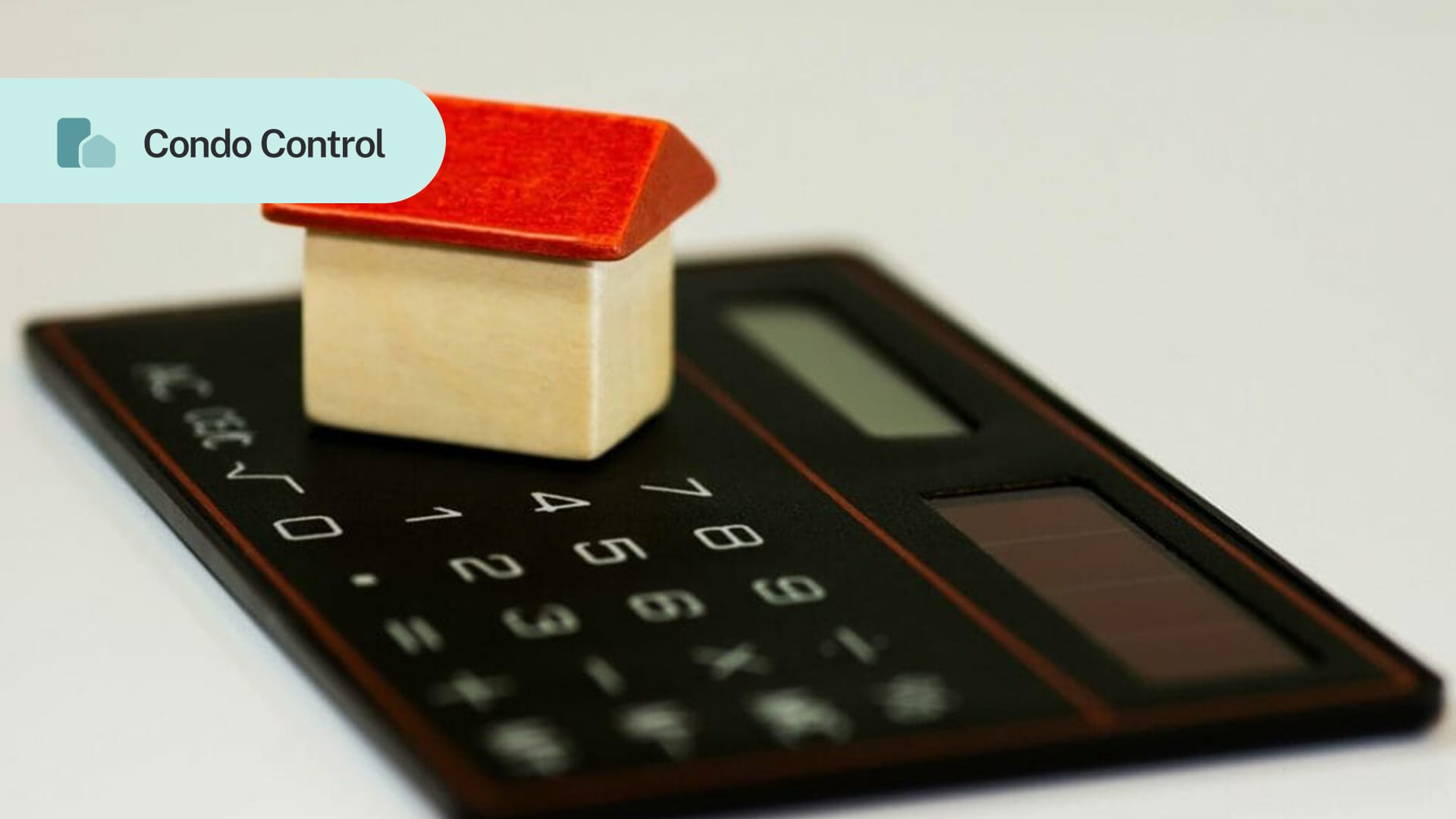If you live in or manage a homeowners association, you know that there are pages of rules to follow. At some point, whether on purpose or by accident, someone will break one of those rules.
Download our violation letter template
When this happens, the board of directors must try to help the owner correct the behavior or action so that they can avoid making the same mistake in the future, and so that everyone knows rules are taken seriously.
Table of contents
- How to approach violations
- How to write a violation letter
- What happens after a violation letter is sent
- The importance of fair enforcement
- What happens when an HOA fails to follow processes properly
Most HOAs refer to breaking the rules as a violation. Some of the most common violations include parking in the wrong spot, leaving the trash can out for too long, poor landscaping, and noise.

How to approach the situation
There are many reasons why homeowners fail to comply with association rules and regulations. Sometimes it’s due to conscious rebellion. Other times, it’s because of simple absent-mindedness. Or, perhaps the owner didn’t even know they were breaking a rule.
Whatever the cause, it’s always a good idea to approach the situation with a goal to help the owner – not shame or blame them. Before the board takes formal action against the homeowner, consider an informal talk with them first. A face-to-face visit or a phone call to give the homeowner a friendly reminder of their obligations is a great way to initiate contact.
Gently remind the owner about the purpose of the rule, followed up by a letter or email that summarizes what was said during the conversation. The goal is to help the homeowner understand the value and purpose of the rule. State clearly how the association will respond should the homeowner break the rule again.
By trying to resolve the situation without issuing a formal notice, you are far more likely to get a positive response from the owner. However, this lenient approach is not always successful. If no corrective action is taken by the owner after an initial warning is given, then the HOA should take the next step in the violation process.
Every HOA will have a different process for addressing violations; some may issue fines after one formal notice, others may be required to issues multiple warnings before a formal notice is given. Whatever the process may be, make sure the association follows it closely.
How to write a violation letter
As the name implies, a violation letter (sometimes referred to as a notice of violation) is meant to inform the homeowner of the violation committed, and the steps required to remedy the issue.
If you’ve never created a violation letter before, use these steps as a guide. Remember to be specific, but keep opinions and emotions out of the document.
Before you send a violation letter to an owner, it’s wise to inform the board of your intentions first. Ideally, violations should be discussed and agreed upon at a board meeting so that the entire board is aware of the violation letter before it goes out.
1. First and foremost, the letter should contain the recipient’s name as well as their full address. The date should be included too so that the owner knows when the notice was created.
2. Provide a detailed written account of the HOA rule that was broken. Cite the rule based on where it appears in the governing documents, indicate how the owner broke that rule, and add any information about when and where the violation was witnessed. After that, explain what the owner must do (or stop doing) in order to resolve the issue.
3. The third step is to include a deadline by which the offending party must rectify the violation. When determining this time frame, it’s important to take into account the type of violation and the amount of time it might take to rectify it. The HOA’s governing documents should state how much time an owner has to remedy the situation. Some states may also have laws about violations and timelines. Following the violation schedule is important because it prevents HOAs from handling violations irregularly or unfairly.
4. The fourth step is to include details about a hearing. Owners almost always have a right to share their side of the story and present their own facts at a formal hearing held in front of the board. It is the association’s obligation to inform the owner of the right, and clearly explain how they can request a hearing.
5. The final step is to send the letter to the offending owner. Many HOAs have the option to send notices electronically, but some may have to send them through registered or certified mail.
HOAs must be patient and follow the process before taking more serious actions
It’s important to note that most HOAs will send two or three violation letters before taking more serious actions. This is done to give the owner ample time to resolve the issue .
Generally, the first letter contains details of the violation and how it impacts the community. The second and/or third letter is more strongly worded than the first. If a fine was issued, the final letter may also inform the owner that further noncompliance may force the board to turn the matter over to a collections agency or an attorney.
When writing an HOA violation letter, it’s important to be mindful of the tone. Use phrases like:
- “We look forward to hearing your side of the story”
- “Please notify us in writing if the rule in question is not applicable to your particular situation”
- “The board has been made aware of a possible misunderstanding”
Keep the tone assertive, positive and professional, keeping in mind that this person is a member of the community and a neighbor to members of the board.
The right to a fair notice

It’s important for HOAs to give homeowners adequate notice of their violation, and an opportunity to rectify the situation.
If your state doesn’t have any regulations on how to handle violations, then it’s up to the HOA to determine a fair and appropriate course of action.
For instance, let’s say an owner has not maintained their yard properly. The lawn is overgrown and there are personal items scattered everywhere. This would be considered a minor issue that is relatively easy to nip in the bud. An owner may only need a week or two to fix this. However, there are more complicated violations like unauthorized construction on a home or illegal installation of certain appliances that aren’t allowed by the CC&Rs. These types of issues will take longer to resolve, and the owner should have a reasonable amount of time to amend the situation.
The right to a hearing
As mentioned earlier, most owners who live in governed communities have a right to a hearing. The right to a hearing is based on a set of basic laws that apply to a number of situations.
Owners must receive advance notice of the hearing as this gives them an opportunity to plan properly for the hearing beforehand. This step in the process can be quite helpful for association members who wish to tell their side of the story, which may be different from what a neighbor reported. They might present new evidence that the board wasn’t aware of.
As preparation for the hearing, the HOA should review what state laws, and its own bylaws, say about the issue. After the hearing, the onus is on the HOA board to give their final verdict on the violation notice.
The board might choose to scrap the violation due to new evidence, or they may choose to fine the offending owner for non-compliance.
Post-hearing process
If your state has processes in place to deal with HOA disputes, then it’s probably a good idea to follow the state-prescribed arbitration process after the hearing.
If your state doesn’t provide any guidance on how to deal with HOA disputes, then your next course of action would be to take the matter to a district court. Should the owner feel dissatisfied with the outcome, there is always the state court of appeals to turn to. It’s important to note that an extensive appeals process is only worth pursuing in cases of extreme violations. Court can be lengthy and expensive. For the most part, HOAs are advised to manage rule violations on their own.
The appeal process
Homeowners have the right to appeal the HOA’s decision. The association bylaws should provide some form of an appeal process, but if they are silent on the matter, boards can see if there are state laws available to guide them. If state laws don’t provide a framework for an appeal process, the next step is a court battle.
The ensuing process would follow the steps of any litigation process based on state rules that govern civil actions. This is the final frontier for any HOA vs. owner battle, and it can cost both parties a lot of money, time and energy.
It can also strain the relationship between the owner and the HOA. That’s why it’s important for the HOA to provide a detailed and comprehensive framework for handling violations, with various alternatives, so that court truly is a last resort.
The importance of fair enforcement
When enforcing CC&Rs, it’s important for the HOA to do so reasonably and without discrimination. That means the HOA should show consistency in its application of community bylaws, especially when it comes to violations.
HOA non-compliance with regard to notice and hearing requirements
What happens when the HOA fails to comply with association rules that govern the notice of violation process? For instance, what if an owner complains that they weren’t given proper notice of the hearing, or that the violation letter did not provide adequate details of the violation?
The HOA ends up doing twice the work. A notice, with all the required information, and within the right timeframe, would need to be reissued to the owner in order to be considered valid.
The HOA board has a responsibility to provide written notice with detailed information on the nature of the violation and the required remedy. It can be tedious, but just like owners, boards must also follow the rules.
Conclusion
Enforcing association rules and regulations is one of the challenges inherent in running a homeowners association. When an owner breaks a rule, it’s the HOA’s responsibility to enforce it.
The association’s CC&Rs documents typically provide guidance on the course of action required in the event of a violation. Sending a warning letter or violation notice is usually the first step in this process.
Download Template
Download our free violation letter template























